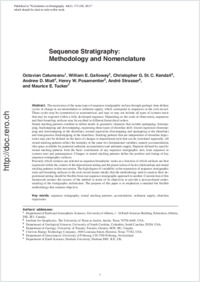Sequence stratigraphy: methodology and nomenclature
- Catuneanu, Octavian Department of Earth and Atmospheric Sciences, University of Alberta, Edmonton, Canada.
- Galloway, William E. Institute for Geophysics, The University of Texas at Austin, USA
- Kendall, Christopher G. St. C. Department of Geological Sciences, University of South Carolina, Columbia, USA
- Miall, Andrew D. Department of Geology, University of Toronto, Canada
- Posamentier, Henry W. Chevron Energy Technology Company, Houston, USA
- Strasser, André Department of Geosciences, University of Fribourg, Switzerland
- Tucker, Maurice E. Department of Earth Sciences, Durham University, UK
-
03.11.2011
Published in:
- Newsletters on Stratigraphy. - 2011, vol. 44, no. 3, p. 173-245
English
The recurrence of the same types of sequence stratigraphic surface through geologic time defines cycles of change in accommodation or sediment supply, which correspond to sequences in the rock record. These cycles may be symmetrical or asymmetrical, and may or may not include all types of systems tracts that may be expected within a fully developed sequence. Depending on the scale of observation, sequences and their bounding surfaces may be ascribed to different hierarchical orders.Stratal stacking patterns combine to define trends in geometric character that include upstepping, forestepping, backstepping and downstepping, expressing three types of shoreline shift: forced regression (forestepping and downstepping at the shoreline), normal regression (forestepping and upstepping at the shoreline) and transgression (backstepping at the shoreline). Stacking patterns that are independent of shoreline trajectories may also be defined on the basis of changes in depositional style that can be correlated regionally. All stratal stacking patterns reflect the interplay of the same two fundamental variables, namely accommodation (the space available for potential sediment accumulation) and sediment supply. Deposits defined by specific stratal stacking patterns form the basic constituents of any sequence stratigraphic unit, from sequence to systems tract and parasequence. Changes in stratal stacking patterns define the position and timing of key sequence stratigraphic surfaces.Precisely which surfaces are selected as sequence boundaries varies as a function of which surfaces are best expressed within the context of the depositional setting and the preservation of facies relationships and stratal stacking patterns in that succession. The high degree of variability in the expression of sequence stratigraphic units and bounding surfaces in the rock record means ideally that the methodology used to analyze their depositional setting should be flexible from one sequence stratigraphic approach to another. Construction of this framework ensures the success of the method in terms of its objectives to provide a process-based understanding of the stratigraphic architecture. The purpose of this paper is to emphasize a standard but flexible methodology that remains objective.
- Faculty
- Faculté des sciences et de médecine
- Department
- Département de Géosciences
- Language
-
- English
- Classification
- Palaeontology
- License
-
License undefined
- Identifiers
-
- RERO DOC 28034
- DOI 10.1127/0078-0421/2011/0011
- Persistent URL
- https://folia.unifr.ch/unifr/documents/302112
Statistics
Document views: 860
File downloads:
- pdf: 2405
